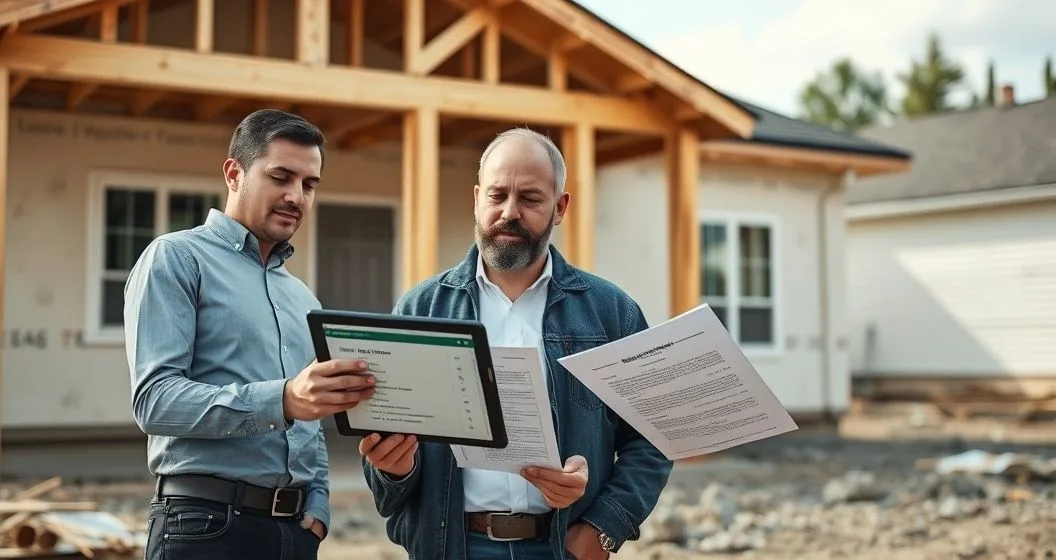Introduction
Short-term rehab loans (six months to two years) fund acquisition plus renovation for residential flips. They include government-backed programs (like the FHA 203(k)) and private options such as hard‑money loans. Lenders typically release rehab funds in staged draws after verification of completed work. Mismanaged draws and weak contractor controls are the leading causes of delays, cost overruns, and mechanics’ lien claims.
How draws typically work
- Draw schedule: Lenders and borrowers agree a draw schedule that ties disbursements to clearly defined milestones (e.g., roof, electrical, drywall, final).
- Inspections and documentation: Most lenders require photo evidence, contractor pay applications, invoices, and an on‑site inspection by a loan inspector or third‑party project manager before releasing funds.
- Retainage and contingency: Lenders often hold retainage (commonly 5–10%) until final completion and reserve a contingency (often 10% of the renovation budget) to cover change orders or overruns.
Practical draw-management checklist
- Agree a detailed draw schedule before closing. Include dollar amounts, milestones, and inspection triggers.
- Require contractor progress invoices and conditional lien waivers for each draw; collect unconditional waivers after payment clears.
- Use photo logs and dated inspection reports (keep them in the loan file).
- Keep a 10% contingency and 5–10% retainage to cover unknowns and punchlist items.
- Consider paying important subs (electrical, HVAC, plumbing) directly or using joint checks to reduce lien risk.
- Use a third‑party project manager or an independent draw inspector for larger flips.
Contractor agreements and protections
- Written contract: Use a scope-of-work contract with line‑item pricing, schedule, accepted materials, payment terms, change‑order process, warranties, insurance and license requirements, and dispute resolution steps.
- Proof of insurance and license: Request Certificate of Insurance (COI) naming you and the lender as additional insured when required.
- Lien waivers: Require conditional waivers tied to each pay application; after payment clears, collect an unconditional waiver from the contractor and major subs.
- Retention clause: Include a retainage clause in the contract that mirrors lender holdbacks.
Common contractor-dispute responses (step-by-step)
- Stop non‑critical payments until the issue is documented and a corrective plan is agreed.
- Document everything: photos, dated notices, change orders, emails, inspection reports, and punch lists.
- Use contract remedies: cure periods, liquidated damages, or withholding retainage as allowed by your contract and state law.
- Protect against liens: verify subs are paid or obtain lien waivers; if a subcontractor files a mechanics’ lien, consult your attorney immediately about a lien bond, bond claim, or lawsuit to clear title.
- Alternative dispute resolution: many contracts call for mediation or arbitration before litigation; these paths are quicker and less costly.
- Notify the lender early: the lender can pause draws, require corrective work, or mandate escrowed funds until the dispute is resolved.
Mechanics’ liens and legal basics
Mechanics’ liens are state-based; deadlines and notice requirements vary. If unpaid subcontractors or suppliers file a lien, that lien can cloud title and block sale/refinance. Typical defenses and responses include:
- Demand for proof of payment and lien waivers.
- Filing a notice to owner (some states require preliminary notice from subs).
- Posting a bond to remove the lien from title while contesting it.
- Negotiating a limited cash payout or escrow to obtain lien releases prior to sale.
Resources and authoritative guidance
- FHA 203(k) loan details (HUD): https://www.hud.gov/program_offices/housing/sfh/203k (information about government rehab lending and allowable repairs).
- General consumer and mortgage guidance (Consumer Financial Protection Bureau): https://www.consumerfinance.gov (guidance on mortgage disclosures and contractor-related consumer protections).
Internal resources
- For background on nontraditional lending that commonly finances flips, see our Hard Money Short-Term Loans article: Hard Money Short-Term Loans: Use Cases for Real Estate Investors.
- For primer on private lending and borrower protections, read: Hard Money and Private Lending: When Investors Use Nontraditional Mortgages.
Common mistakes to avoid
- Releasing draws without signed lien waivers.
- Neglecting written change orders for scope or price changes.
- Paying the general contractor without confirming subs have been paid.
- Skipping permit/inspection compliance—lenders and buyers require permits for significant work.
Example scenario
An investor budgets $50,000 for renovations with a 10% contingency and a 10% retainage holdback. The lender releases an initial draw of $15,000 at closing for immediate demo and permits after proof of COI and the signed contract. At each subsequent draw the investor submits contractor pay apps, photos, and inspection reports. When a subcontractor later threatens a lien, the investor uses documented pay apps and collected waivers to negotiate a limited escrow payout and clears title before listing the property.
Final best practices (quick list)
- Put scope, schedule, pricing, contingency, retainage, and dispute remedies in writing.
- Collect conditional waivers with each draw and unconditional waivers after payment.
- Verify licenses, COIs, and permits up front.
- Keep the lender informed and use an independent inspector on significant projects.
Professional disclaimer
This content is educational only and not individualized legal, tax, or lending advice. For case‑specific guidance, consult a licensed real estate attorney, your lender, or a qualified financial advisor.
Authoritative links
- HUD — FHA 203(k) Program: https://www.hud.gov/program_offices/housing/sfh/203k
- Consumer Financial Protection Bureau: https://www.consumerfinance.gov



